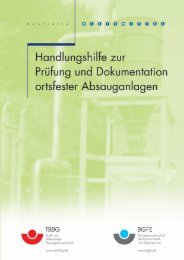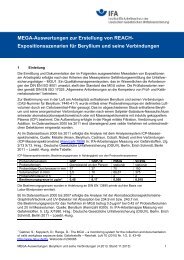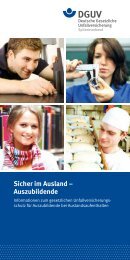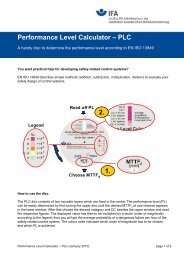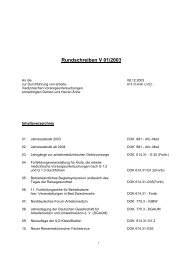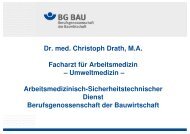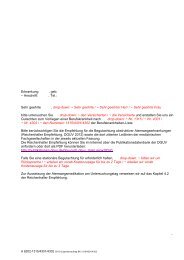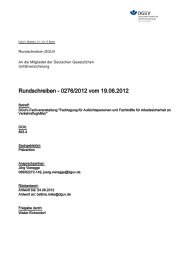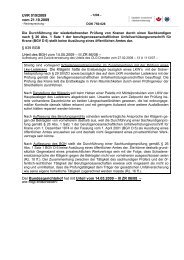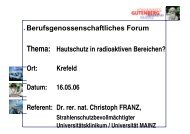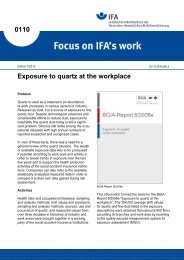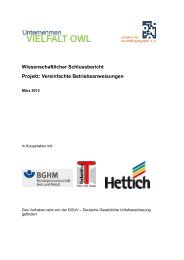Effectiveness of measures to prevent needlestick injuries among ...
Effectiveness of measures to prevent needlestick injuries among ...
Effectiveness of measures to prevent needlestick injuries among ...
Create successful ePaper yourself
Turn your PDF publications into a flip-book with our unique Google optimized e-Paper software.
5 Cost effectiveness<br />
5.2.3.2 Needleless IV systems<br />
Gartner described the introduction <strong>of</strong> a needleless IV system in a 500-bed acute care<br />
US hospital in 1990. The cost <strong>of</strong> a NSI was estimated at US $ 371 and included test-<br />
ing, one HBV vaccine, lost employee working time and probably costs for health care<br />
personnel involved in caring for injured HCW. The increase in the purchase price <strong>of</strong><br />
the new system was US $ 6,542 per half-year, only a 16 % increase over baseline. In<br />
this report, there was a drastic reduction in equipment needs, since the new system<br />
was largely reusable. The number <strong>of</strong> IV-related <strong>needlestick</strong>s decreased from 17 <strong>to</strong> 2<br />
within a half-year after implementation, leading <strong>to</strong> savings <strong>of</strong> US $ 5,595. Therefore,<br />
the new system led <strong>to</strong> a net increase <strong>of</strong> $ 94 per half-year [48]. Similar results, cost<br />
savings through reduced tubing use, from about $ 10 per patient <strong>to</strong> $ 8 per patient<br />
were reported by Skolnick et al., but the authors had no data related <strong>to</strong> costs <strong>of</strong> NSI<br />
[58].<br />
Fassel et al. reported direct costs for NSI <strong>of</strong> US $ 531 but provided no details as <strong>to</strong><br />
which costs were included in the calculation. The annual incremental costs <strong>of</strong> the new<br />
system (Interlink) were $ 195,000 in 1992. If fully implemented (there was residual use<br />
<strong>of</strong> conventional equipment during the observation period), savings would amount <strong>to</strong><br />
$ 42,000, leading <strong>to</strong> <strong>to</strong>tal incremental costs <strong>of</strong> about $ 153,000/year [56].<br />
The cost-benefit analysis <strong>of</strong> Orenstein et al. has already been described, above,<br />
<strong>to</strong>gether with the implementation <strong>of</strong> a safety syringe [33].<br />
Yassi et al. evaluated the implementation <strong>of</strong> the InterLink System (Baxter) in a large<br />
Canadian hospital in 1992/1993. The costs <strong>of</strong> NSI were estimated <strong>to</strong> range from CAN<br />
$ 83 for a known seronegative source patient <strong>to</strong> CAN $ 559 for a known seropositive<br />
source patient. Estimated costs included testing, PEP for HBV (no Zidovudine prophy-<br />
laxis; no HCV testing) and lost work time <strong>of</strong> affected employees, health personnel<br />
treating the injured HCW, and administrative costs. The incremental annual costs for<br />
the needleless system were estimated <strong>to</strong> be about CAN $ 47,800, a 14 % increase.<br />
The authors, like others above, also reported a decrease in the number <strong>of</strong> pieces <strong>of</strong><br />
equipment needed with the new system. There was an additional saving <strong>of</strong> 15 %<br />
(CAN $ 13,200) from reduced disposal costs, because the new system is not classified<br />
as sharps [54].<br />
Report „Needlestick <strong>injuries</strong>“ 65



